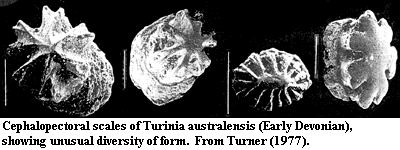 Taxa on This Page
Taxa on This Page| Thelodonti | ||
| The Vertebrates | Thelodontida (2) |
| Vertebrates Home | Vertebrate | Vertebrate |
|
Abbreviated Dendrogram
Vertebrata
├─Conodonta
└─┬─Pteraspidomorphi
└─Thelodonti
├─┬─Furcacaudiformes
│ └─Thelodontida
│ ├─┬─Archipelepididae
│ │ └─Turiniidae
│ └─┬─Apalolepididae
│ └─Lanarkia
└─┬─┬─Katoporida
│ └─Cephalaspidomorphi
│ ├─Galeaspida
│ └─┬─Pituriaspida
│ ├─Osteostraci
│ └─Gnathostomata (conventional placement)
└─┬─Loganiidae
└─Gnathostomata (alternate placement)
├─Placodermi
└─┬─Chondrichthyes
└─Teleostomi
|
Contents
Overview |
 Taxa on This Page
Taxa on This Page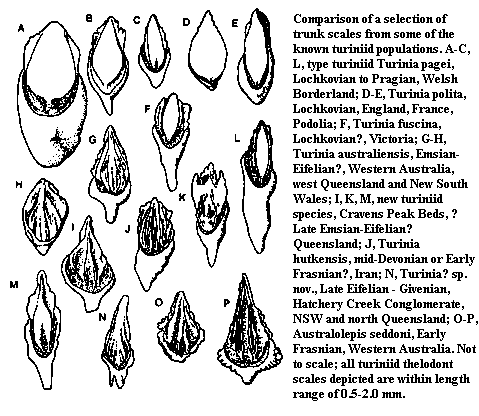 Turiniidae: Australolepis?, Boreania, Turinia
Turiniidae: Australolepis?, Boreania, Turinia
Range: Late Silurian (Pridoli) to Late Devonian (Frasnian) of Antarctica, Australia, Siberia, South America, Europe, Baltics.
Phylogeny: Thelodontida::: Archipelepididae + *.
Characters: large buccopharyngeal cavity present [DS01]; buccopharyngeal cavity probably lined with very small (~0.5 mm), tear-drop shaped scales with their tapering end pointed directly anteriorly closer to the animal's midline, with scales further from it pointing more anteromedially (if we understand their description correctly) [DS01]; probably 8 ventral gill pairs represented by transverse lines which appear to be divided into medial, lateral and outer segments [DS01]; anteriorly "pointing" minute denticles also associated with lateral regions of lateral ridges [DS01]; cephalothorax ("head" region) terminates rather abruptly, tapering dramatically to trunk region [DS01]; dorsal scale ridge may have been present [DS01]; anal fin ?absent [DS01]; tail hypochordal [DS01]; pectoral fins or equivalent structures without fin rays [DS01]; pectoral fins with dorsal covering of larger, rhombic scales [DS01]; scales 0.2-3.5 mm [BG02]; high scales with large, high, irregular base [BG02]; base more massive than crown [S+01]; 1-2 pulp openings [BG02]; 1-3 pulp canals, often branched [BG02*]; outline of pulp cavity complex and indistinct [K02]; dentine tubules long & often highly dilated towards pulp cavity [BG02] [K02]; crown high [BG02*]; head scales round to oval with crenulated or notched crown margins and vertical lateral ribs [BG02*]; transitional scales elliptical, boat-shaped and often asymmetrical [BG02*]; trunk scales boat-shaped with lateral ridges & their projections on crown [BG02*]; stomach present (sediment infill differs from matrix) and sharply delimited from rest of trunk [DS01]; .
Comments: One of the main thelodont families of the Early Devonian of Northern Hemisphere, where Turinia is very widely distributed, [BG02] and virtually the only Gondwanan thelodont family [T97]. The first appearance of Turinia pagei defines the Silurian-Devonian boundary. [BG02].
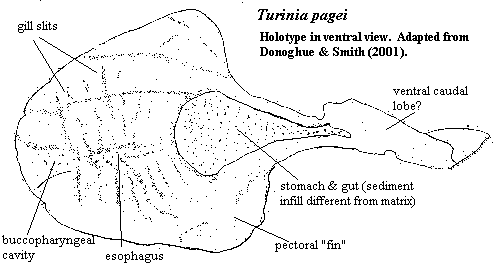
[BG02*] relates to Turinia, by far the most common member of the taxon.
[BG02] note that some turiniid scales resemble nikoliviid scales in crown view, which tends to confirm our suspicion that nikoliviids are closer to thelodontids than to katoporids.
Links: FISH 00 Best on the Web); MsoDockBottom; MICROVERTEBRATE CORRELATION OF LOWER DEVONIAN STRATA, CENTRAL- ....
References: Blom & Goujet 2002) [BG02]; Soehn et al. (2001) [S+01]; Donoghue & Smith (2001) [DS01]; Karatajute-Talimaa (2002) [K02]; Turner (1997) [T97]. ATW030619.
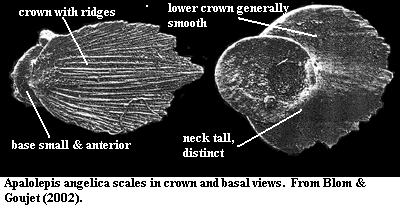 Apalolepididae: Apalolepis, Skamolepis
Apalolepididae: Apalolepis, Skamolepis
Range: Early Devonian (Lochkovian - Pragian) of Spitsbergen & The Ukraine [BG02].
Phylogeny: Thelodontida::: Lanarkia+ *.
Characters: scales ≤ 1.25 mm [BG02]; basal layer very thin [BG02]; base very small & anteriorly placed [J96] [BG02]; pulp cavity low & wide, with ?posterior branches [J96] [BG02]; dentine tubules sinuous, slightly irregular & dilated close to pulp cavity [BG02]; neck high & distinct [BG02]; large, usually flat, thin, foliate crown [BG02]; crown broadly expanded, orthodentine [J96]; lower crown smooth & flat or concave [BG02]; crown upper surface with ridges [BG02].
References: Blom & Goujet 2002) [BG02]; Janvier (1996) [J96]. ATW030606.
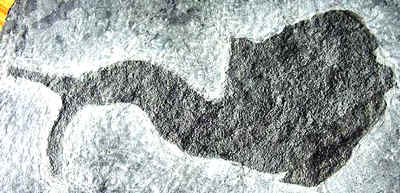 Lanarkia: Traquair 1898. L. horrida Traquair 1898 (= L. spinosa Traquair 1898 [1]); L. lanceolata Marss 1998; L. spinulosa Traquair 1898 (fragmentary -- could be Shielia per [MR98]).
Lanarkia: Traquair 1898. L. horrida Traquair 1898 (= L. spinosa Traquair 1898 [1]); L. lanceolata Marss 1998; L. spinulosa Traquair 1898 (fragmentary -- could be Shielia per [MR98]).
Range: Early Silurian to Late Silurian (but mostly Wenlock) of Europe (Scotland & Sweden) and North America (Arctic Canada).
Phylogeny: Thelodontida::: Apalolepididae + *.
Characters: small, to 20 cm [MR98]; cephalothorax broad & dorsoventrally compressed (no specimens found in lateral view) [MR98]; mouth nearly terminal [MR98]; rostrum wide & blunt [MR98]; eyes behind anterolateral corners of head [MR98]; pectoral fins reach almost to anterior margin of head [MR98]; broadly separated eyes [J96]; probably 8 gill pairs [MR98]; gills probably ventrally, medial to fins [J96]; crescent-shaped patches of elongated scales just posterior to pectoral fins [MR98]; body narrows rapidly behind pectoral fins [MR98]; forked tail [J96]; dorsal & anal fin weakly developed, with dorsal fin inferred from presence of mid-dorsal ridge of large, conical spines [MR98]; tail slender [MR98]; notochord continues into upper caudal lobe [MR98]; caudal fin probably heterocercal, with upper lobe longer & 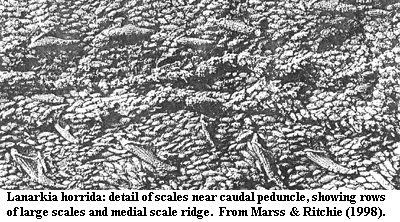 stronger and ventral lobe wider & multilobate [MR98]; small, triangular lateral fins [J96]; dorsal and ventral scale patterns very similar, with large scales on dorsal side more likely to be nearly vertical and unstriated, while ventral side has fewer large scales with smooth surfaces and may exhibit alternation of denticulated patches with normal scales over the branchial area [MR98]; pulp cavity wide, narrowing into pulp canal [MR98]; scales spine-shaped, with some very large and aligned in longitudinal rows [J96]; scales conical, lanceolate or trilobate scales alternating with rows of larger (trumpet-shapes) scales [MR98]; most scales with striated or ridged [MR98].
stronger and ventral lobe wider & multilobate [MR98]; small, triangular lateral fins [J96]; dorsal and ventral scale patterns very similar, with large scales on dorsal side more likely to be nearly vertical and unstriated, while ventral side has fewer large scales with smooth surfaces and may exhibit alternation of denticulated patches with normal scales over the branchial area [MR98]; pulp cavity wide, narrowing into pulp canal [MR98]; scales spine-shaped, with some very large and aligned in longitudinal rows [J96]; scales conical, lanceolate or trilobate scales alternating with rows of larger (trumpet-shapes) scales [MR98]; most scales with striated or ridged [MR98].
Comments: The synonymy of L. horrida and L. spinosa is predicated on Marss & Ritchie's [MR98] observation that they are two different growth stages of the same species. Other articulated thelodonts sometimes show a mixture of scale sizes. However, those specimens are juvenile, and the squamation becomes more uniform with age. Only in Lanarkia does this characteristic routinely persist into adulthood. Interestingly, the juvenile squamation of Lanarkia is almost homogenous, consisting of the relatively large, upwardly-directed conical scales with "trumpet-like bases."
Image: color image of fossil from PALAEOZOIC FOSSILS UK.
Links: New Page 1.
References: Janvier (1996) [J96]; Marss & Ritchie (1998) [MR98]. ATW030620.
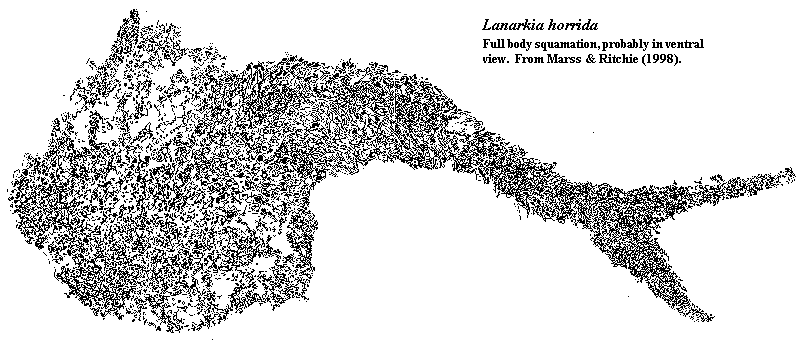
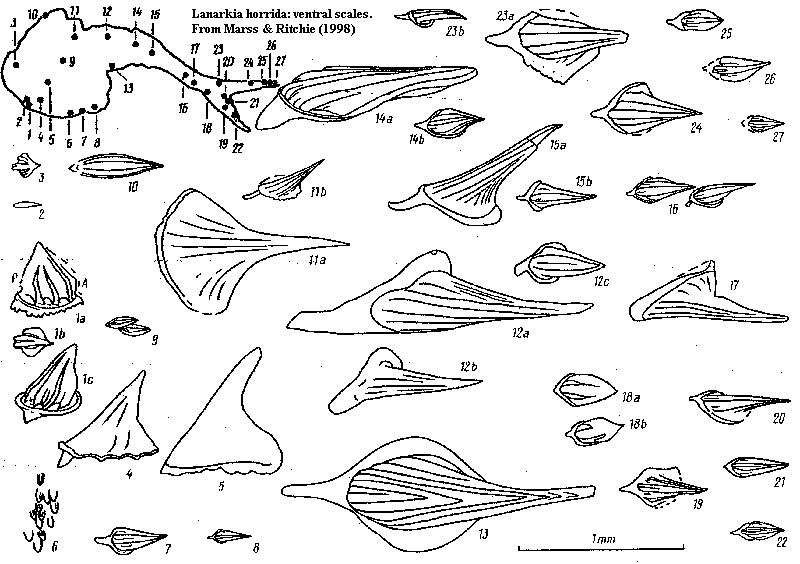
checked ATW050524